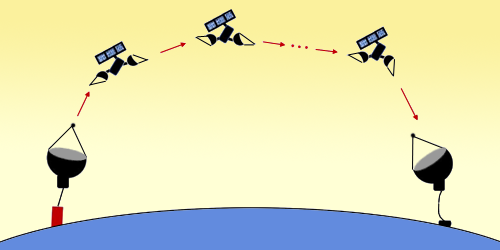Global Quantum Communication via a Satellite Train
Long-distance quantum communication can be achieved by directly sending light through space using a train of orbiting satellites that function as optical lenses.
Transferring quantum information between widely separated locations is necessary to develop a global quantum network. This project is hindered by the high photon loss inherent to long-distance fiber-based transmission—the default for photonic qubits. To get around this problem, researchers have demonstrated the transmission of a quantum signal via satellite instead (see Viewpoint: Paving the Way for Satellite Quantum Communications). Now Sumit Goswami of the University of Calgary, Canada, and Sayandip Dhara of the University of Central Florida show how quantum information could be relayed over large distances by a network of such satellites [1].
The scheme involves a train of satellites in low-Earth orbit, each equipped with a pair of reflecting telescopes. A given satellite would receive a photonic qubit using one telescope and transmit the qubit onward using the other. The satellite train would effectively bend photons around Earth’s curvature while controlling photon loss due to beam divergence. The team likens the scheme to a set of lenses on an optical table.
Simulations of satellites 120 km apart with 60-cm-diameter telescopes showed that beam-divergence loss vanished. Over a distance of 20,000 km, total losses—primarily reflection loss but also alignment and focusing errors—could be reduced to orders of magnitude less than those of a few hundred kilometers of optical fiber. Ultrahigh-reflectivity telescope mirrors could further decrease this loss.
Goswami and Dhara examined two protocols based on such a setup. In one, two entangled photons are transmitted in opposite directions from a satellite-based source. In the other, qubits are transmitted unidirectionally, with source and detector both on the ground. Despite the effects of atmospheric turbulence, the latter performed well and has the advantage of keeping the necessary quantum hardware on Earth.
–Rachel Berkowitz
Rachel Berkowitz is a Corresponding Editor for Physics Magazine based in Vancouver, Canada.
References
- S. Goswami and S. Dhara, “Satellite-relayed global quantum communication without quantum memory,” Phys. Rev. Appl. 20, 024048 (2023).


